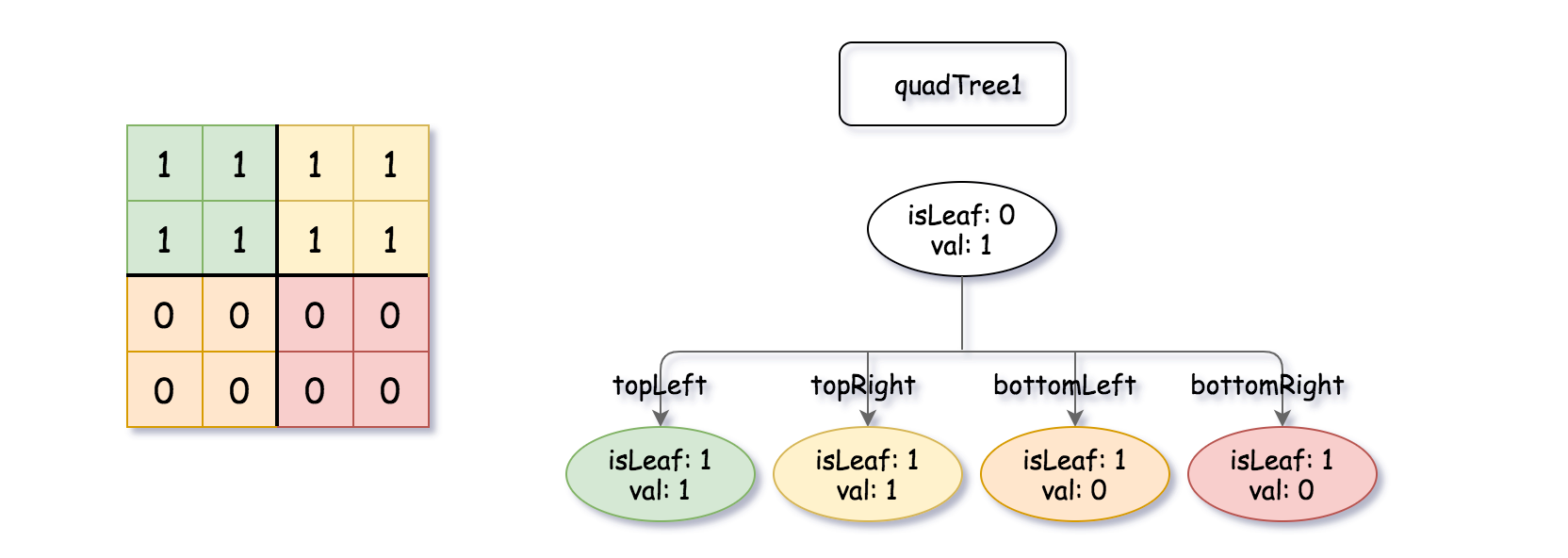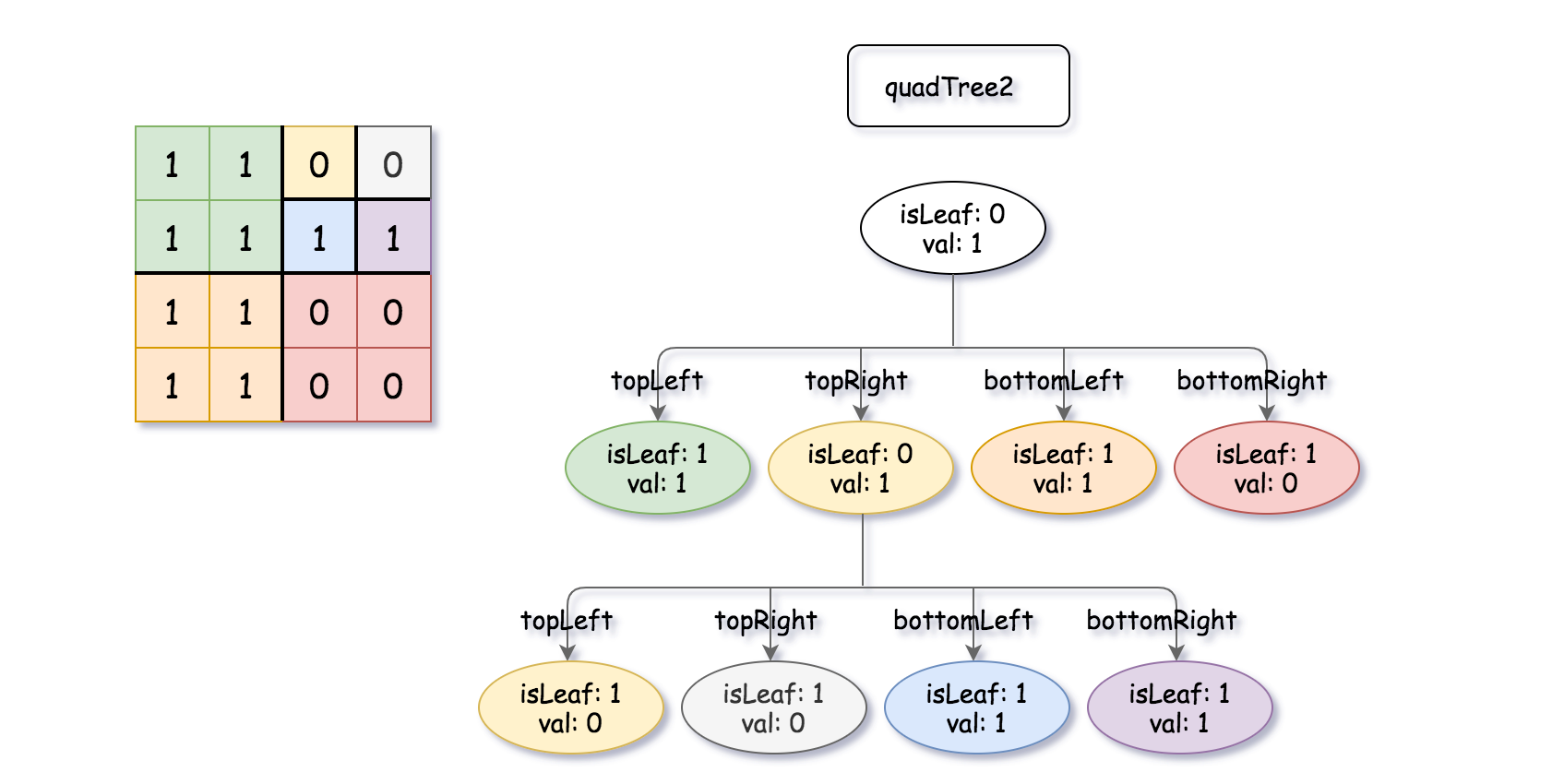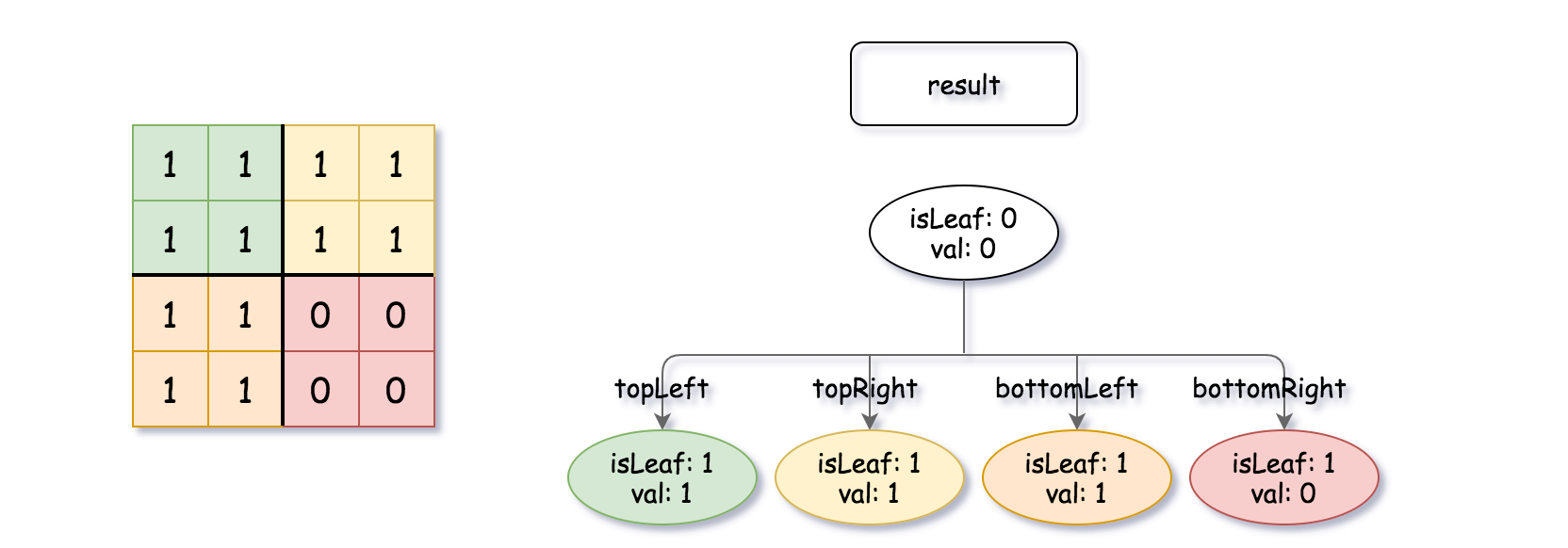二进制矩阵中的所有元素不是 0 就是 1 。
给你两个四叉树,quadTree1 和 quadTree2。其中 quadTree1 表示一个 n * n 二进制矩阵,而 quadTree2 表示另一个 n * n 二进制矩阵。
请你返回一个表示 n * n 二进制矩阵的四叉树,它是 quadTree1 和 quadTree2 所表示的两个二进制矩阵进行 按位逻辑或运算 的结果。
注意,当 isLeaf 为 False 时,你可以把 True 或者 False 赋值给节点,两种值都会被判题机制 接受 。
四叉树数据结构中,每个内部节点只有四个子节点。此外,每个节点都有两个属性:
val:储存叶子结点所代表的区域的值。1 对应 True,0 对应 False;isLeaf: 当这个节点是一个叶子结点时为 True,如果它有 4 个子节点则为 False 。
class Node {
public boolean val;
public boolean isLeaf;
public Node topLeft;
public Node topRight;
public Node bottomLeft;
public Node bottomRight;
}
我们可以按以下步骤为二维区域构建四叉树:
- 如果当前网格的值相同(即,全为
0或者全为1),将isLeaf设为 True ,将val设为网格相应的值,并将四个子节点都设为 Null 然后停止。 - 如果当前网格的值不同,将
isLeaf设为 False, 将val设为任意值,然后如下图所示,将当前网格划分为四个子网格。 - 使用适当的子网格递归每个子节点。
如果你想了解更多关于四叉树的内容,可以参考 wiki 。
四叉树格式:
输出为使用层序遍历后四叉树的序列化形式,其中 null 表示路径终止符,其下面不存在节点。
它与二叉树的序列化非常相似。唯一的区别是节点以列表形式表示 [isLeaf, val] 。
如果 isLeaf 或者 val 的值为 True ,则表示它在列表 [isLeaf, val] 中的值为 1 ;如果 isLeaf 或者 val 的值为 False ,则表示值为 0 。
示例 1:
输入:quadTree1 = [[0,1],[1,1],[1,1],[1,0],[1,0]] , quadTree2 = [[0,1],[1,1],[0,1],[1,1],[1,0],null,null,null,null,[1,0],[1,0],[1,1],[1,1]] 输出:[[0,0],[1,1],[1,1],[1,1],[1,0]] 解释:quadTree1 和 quadTree2 如上所示。由四叉树所表示的二进制矩阵也已经给出。 如果我们对这两个矩阵进行按位逻辑或运算,则可以得到下面的二进制矩阵,由一个作为结果的四叉树表示。 注意,我们展示的二进制矩阵仅仅是为了更好地说明题意,你无需构造二进制矩阵来获得结果四叉树。
示例 2:
输入:quadTree1 = [[1,0]] , quadTree2 = [[1,0]] 输出:[[1,0]] 解释:两个数所表示的矩阵大小都为 1*1,值全为 0 结果矩阵大小为 1*1,值全为 0 。
示例 3:
输入:quadTree1 = [[0,0],[1,0],[1,0],[1,1],[1,1]] , quadTree2 = [[0,0],[1,1],[1,1],[1,0],[1,1]] 输出:[[1,1]]
示例 4:
输入:quadTree1 = [[0,0],[1,1],[1,0],[1,1],[1,1]] , quadTree2 = [[0,0],[1,1],[0,1],[1,1],[1,1],null,null,null,null,[1,1],[1,0],[1,0],[1,1]] 输出:[[0,0],[1,1],[0,1],[1,1],[1,1],null,null,null,null,[1,1],[1,0],[1,0],[1,1]]
示例 5:
输入:quadTree1 = [[0,1],[1,0],[0,1],[1,1],[1,0],null,null,null,null,[1,0],[1,0],[1,1],[1,1]] , quadTree2 = [[0,1],[0,1],[1,0],[1,1],[1,0],[1,0],[1,0],[1,1],[1,1]] 输出:[[0,0],[0,1],[0,1],[1,1],[1,0],[1,0],[1,0],[1,1],[1,1],[1,0],[1,0],[1,1],[1,1]]
提示:
quadTree1和quadTree2都是符合题目要求的四叉树,每个都代表一个n * n的矩阵。n == 2^x,其中0 <= x <= 9.
"""
# Definition for a QuadTree node.
class Node:
def __init__(self, val, isLeaf, topLeft, topRight, bottomLeft, bottomRight):
self.val = val
self.isLeaf = isLeaf
self.topLeft = topLeft
self.topRight = topRight
self.bottomLeft = bottomLeft
self.bottomRight = bottomRight
"""
class Solution:
def intersect(self, quadTree1: "Node", quadTree2: "Node") -> "Node":
def dfs(t1, t2):
if t1.isLeaf and t2.isLeaf:
return Node(t1.val or t2.val, True)
if t1.isLeaf:
return t1 if t1.val else t2
if t2.isLeaf:
return t2 if t2.val else t1
res = Node()
res.topLeft = dfs(t1.topLeft, t2.topLeft)
res.topRight = dfs(t1.topRight, t2.topRight)
res.bottomLeft = dfs(t1.bottomLeft, t2.bottomLeft)
res.bottomRight = dfs(t1.bottomRight, t2.bottomRight)
isLeaf = (
res.topLeft.isLeaf
and res.topRight.isLeaf
and res.bottomLeft.isLeaf
and res.bottomRight.isLeaf
)
sameVal = (
res.topLeft.val
== res.topRight.val
== res.bottomLeft.val
== res.bottomRight.val
)
if isLeaf and sameVal:
res = res.topLeft
return res
return dfs(quadTree1, quadTree2)/*
// Definition for a QuadTree node.
class Node {
public boolean val;
public boolean isLeaf;
public Node topLeft;
public Node topRight;
public Node bottomLeft;
public Node bottomRight;
public Node() {}
public Node(boolean _val,boolean _isLeaf,Node _topLeft,Node _topRight,Node _bottomLeft,Node
_bottomRight) { val = _val; isLeaf = _isLeaf; topLeft = _topLeft; topRight = _topRight; bottomLeft =
_bottomLeft; bottomRight = _bottomRight;
}
};
*/
class Solution {
public Node intersect(Node quadTree1, Node quadTree2) {
return dfs(quadTree1, quadTree2);
}
private Node dfs(Node t1, Node t2) {
if (t1.isLeaf && t2.isLeaf) {
return new Node(t1.val || t2.val, true);
}
if (t1.isLeaf) {
return t1.val ? t1 : t2;
}
if (t2.isLeaf) {
return t2.val ? t2 : t1;
}
Node res = new Node();
res.topLeft = dfs(t1.topLeft, t2.topLeft);
res.topRight = dfs(t1.topRight, t2.topRight);
res.bottomLeft = dfs(t1.bottomLeft, t2.bottomLeft);
res.bottomRight = dfs(t1.bottomRight, t2.bottomRight);
boolean isLeaf = res.topLeft.isLeaf && res.topRight.isLeaf && res.bottomLeft.isLeaf
&& res.bottomRight.isLeaf;
boolean sameVal = res.topLeft.val == res.topRight.val
&& res.topRight.val == res.bottomLeft.val && res.bottomLeft.val == res.bottomRight.val;
if (isLeaf && sameVal) {
res = res.topLeft;
}
return res;
}
}/*
// Definition for a QuadTree node.
class Node {
public:
bool val;
bool isLeaf;
Node* topLeft;
Node* topRight;
Node* bottomLeft;
Node* bottomRight;
Node() {
val = false;
isLeaf = false;
topLeft = NULL;
topRight = NULL;
bottomLeft = NULL;
bottomRight = NULL;
}
Node(bool _val, bool _isLeaf) {
val = _val;
isLeaf = _isLeaf;
topLeft = NULL;
topRight = NULL;
bottomLeft = NULL;
bottomRight = NULL;
}
Node(bool _val, bool _isLeaf, Node* _topLeft, Node* _topRight, Node* _bottomLeft, Node* _bottomRight) {
val = _val;
isLeaf = _isLeaf;
topLeft = _topLeft;
topRight = _topRight;
bottomLeft = _bottomLeft;
bottomRight = _bottomRight;
}
};
*/
class Solution {
public:
Node* intersect(Node* quadTree1, Node* quadTree2) {
return dfs(quadTree1, quadTree2);
}
Node* dfs(Node* t1, Node* t2) {
if (t1->isLeaf && t2->isLeaf) return new Node(t1->val || t2->val, true);
if (t1->isLeaf) return t1->val ? t1 : t2;
if (t2->isLeaf) return t2->val ? t2 : t1;
Node* res = new Node();
res->topLeft = dfs(t1->topLeft, t2->topLeft);
res->topRight = dfs(t1->topRight, t2->topRight);
res->bottomLeft = dfs(t1->bottomLeft, t2->bottomLeft);
res->bottomRight = dfs(t1->bottomRight, t2->bottomRight);
bool isLeaf = res->topLeft->isLeaf && res->topRight->isLeaf && res->bottomLeft->isLeaf && res->bottomRight->isLeaf;
bool sameVal = res->topLeft->val == res->topRight->val && res->topRight->val == res->bottomLeft->val && res->bottomLeft->val == res->bottomRight->val;
if (isLeaf && sameVal) res = res->topLeft;
return res;
}
};/**
* Definition for a QuadTree node.
* type Node struct {
* Val bool
* IsLeaf bool
* TopLeft *Node
* TopRight *Node
* BottomLeft *Node
* BottomRight *Node
* }
*/
func intersect(quadTree1 *Node, quadTree2 *Node) *Node {
var dfs func(*Node, *Node) *Node
dfs = func(t1, t2 *Node) *Node {
if t1.IsLeaf && t2.IsLeaf {
return &Node{Val: t1.Val || t2.Val, IsLeaf: true}
}
if t1.IsLeaf {
if t1.Val {
return t1
}
return t2
}
if t2.IsLeaf {
if t2.Val {
return t2
}
return t1
}
res := &Node{}
res.TopLeft = dfs(t1.TopLeft, t2.TopLeft)
res.TopRight = dfs(t1.TopRight, t2.TopRight)
res.BottomLeft = dfs(t1.BottomLeft, t2.BottomLeft)
res.BottomRight = dfs(t1.BottomRight, t2.BottomRight)
isLeaf := res.TopLeft.IsLeaf && res.TopRight.IsLeaf && res.BottomLeft.IsLeaf && res.BottomRight.IsLeaf
sameVal := res.TopLeft.Val == res.TopRight.Val && res.TopRight.Val == res.BottomLeft.Val && res.BottomLeft.Val == res.BottomRight.Val
if isLeaf && sameVal {
res = res.TopLeft
}
return res
}
return dfs(quadTree1, quadTree2)
}


